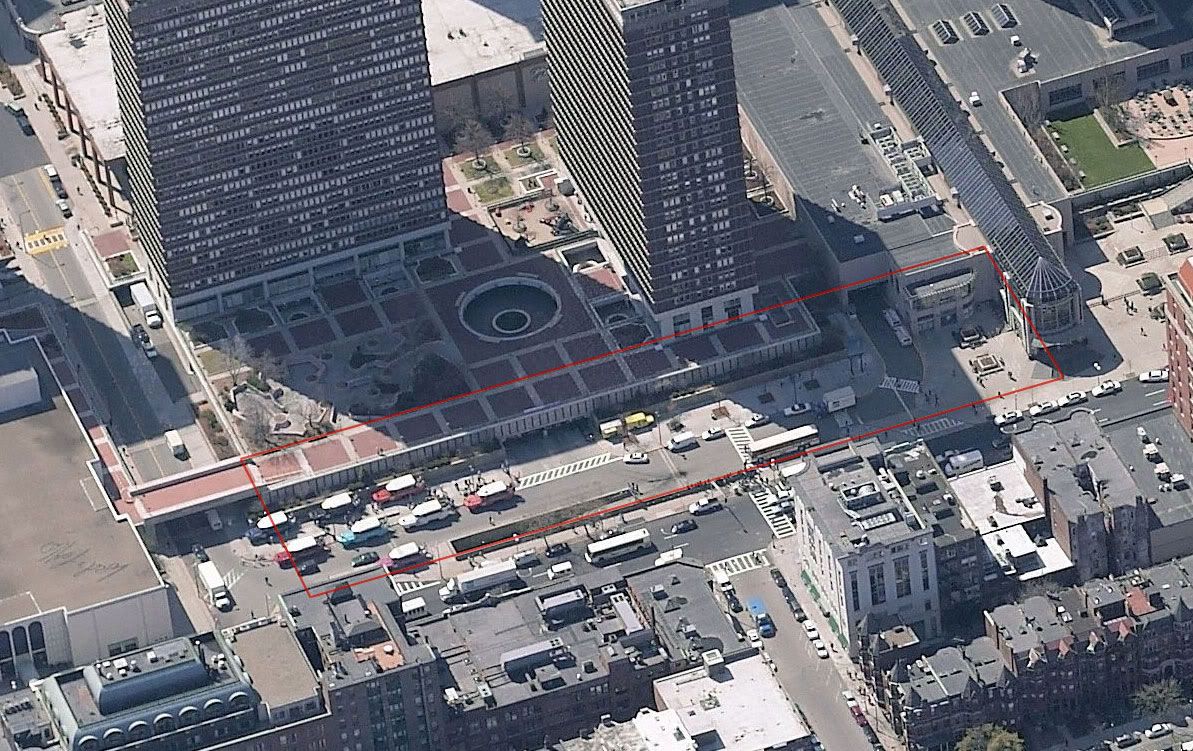Re: Mandarin Oriental
OUCH....The Mandarin gets roasted
http://www.boston.com/lifestyle/articles/2008/10/07/the_boil_on_boylston_street/
About two weeks ago, I was at the Hynes Convention Center and ate supper across Boylston Street. As I emerged from the restaurant, a monstrous, shadowy cliff rose up in front of me, creating a dank urban canyon where there had been open space before. And then I saw the open fan logo "greeting" me from the fa?ade.
The Mandarin Oriental, Boston. Ugh.
A few years ago, I saw a model of this building at the offices of CBT/Childs Bertman Tseckares architects, which prompted me to call partner Richard Bertman - he of the notorious R2D2 building - "the butcher of Boylston Street." After my recent nocturnal encounter, I returned to see the Mandarin in the daylight. I still hated it. The opposite side of Boylston, with its broad, active sidewalk, has four wonderful outdoor cafes, buildings that rise only a few stories, and some nicely scaled signature pieces, like the new Apple store, and the Planet Hollywood building, now Priscilla of Boston.
But across the street, on the Mandarin side - nothing. The brick and limestone mountain rises 155 feet straight up off the narrow sidewalk. For a full block and a half, the Mandarin offers nothing to the passerby, except perhaps an envious glance at how the other half lives. There is a nondescript hotel entrance, or you can peek into the "M" bar ("artisan cheeses . . . Asian-style tapas") or into L'Espalier, a restaurant where actual humans can't afford to eat.
My three-word architectural review of the Mandarin: Gag, gag, gag.
How did this happen? I thought the Boston Redevelopment Authority had a policy forbidding the "canyonization" of Boylston Street. Years ago the BRA stared down developers who wanted to plant Manhattan-style skyscrapers across from the New England Life building. What resulted - Philip Johnson's 500 Boylston and Robert Stern's 222 Berkeley - is far from perfect, but their huge towers are set well back from the street.
Not so the Mandarin, which juts forward to within a few inches of its property line. (The 15-foot-wide sidewalk is mandated by city zoning.) "Of course we want to avoid canyonization," explains BRA senior architect David Carlson. "If you're standing on the hotel's side of Boylston, there's not so much massing." Well, sure. That's because you can't see the Oriental!
Appearances notwithstanding, I am a fair-minded person. I phoned CBT and told them what I was up to. Cue the nightmare scenario: I had to walk the length of Boylston Street with Alfred Wojciechowski, who designed the Mandarin, and, coincidentally, the more interesting Planet Hollywood building across the street. It gets worse. Wojciechowski is young, ebullient, articulate and . . . Canadian. No fair! Everyone knows I can't resist the blandishments of the Frozen North.
Wojciechowski could charm the birds from the trees. As we start walking west from the Women's Educational and Industrial Union building, he likens the Boylston vista to a cake studded with tasty raisins. "Now we are walking through the batter," is one of his more memorable quotations. The raisins are the architectural gems, like the old Shreve, Crump & Low building and Old South Church. The batter is what he calls "background architecture," nothingburger buildings that you don't even notice are there.
As we approach the Mandarin from Copley Square, Wojciechowski has me half-convinced that the Prudential Tower and the rest of the ghastly "build out" - the urban renewal-like Avalon Bay towers, R2D2, 101 Huntington - are a sophisticated experiment in post-Le Corbusier modernism. Oh, come on. I call the Pru and its environs "reverse Dresden," meaning it's a part of the world that should have been fire-bombed, compared to Dresden, which should have been spared.
Wojciechowski and I halt at the corner of Fairfield and Boylston, in the lee of his monstrous creation. "Alfred," I say, "Can't you feel how we are hemmed in here?"
"Alex," he assures me. "We're not hemmed in. We are enclosed."
He did show me some nice touches. There are at least six public cut-throughs transecting the Oriental complex, which would allow you to enter the hotel from Boylston and keep on walking south to Huntington Avenue. When he says, "We have extended the city two blocks to the west," that's partially true. There is a new nexus of "action" west of Copley Square - stores, apartments, lodging, and restaurants - anchored by the Sheraton, the Shops at Prudential Center, and the Mandarin.
Is the Mandarin the ugliest building in Boston? Let's be reasonable - it's not Harbor Towers, a creation of the talented Henry Cobb, who also gave us the John Hancock Tower. Many great architects build one bad building, Mr. Wojciechowski, and I am afraid this one is yours.


